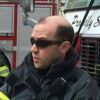The first week of October has long been special for the fire service in the United States.
In 1922, the NFPA used that week to commemorate the Great Chicago Fire of 1871, and in 1925, President Calvin Coolidge proclaimed it the first federally recognized National Fire Prevention Week.
Historians have done a good job covering the October 1871 Great Chicago Fire, along with the famous story of Mrs. O’Leary’s cow. They haven’t done as strong a job recognizing another massive conflagration that occurred simultaneously – at least not beyond a side reference. As a result, far fewer people know the story of the Peshtigo Fire.
The Peshtigo Fire burned over 1 million acres, destroyed thousands of buildings, and killed over 1,500 people, most in northeastern Wisconsin – the deadliest forest fire in U.S. history. By the end of the incident, 16 towns had been burned. Unless you’re from the area or are a fire science student, there’s a good chance you’ve never heard of this “other” major October fire.
Detailing the Peshtigo Fire
Peshtigo is a small city in Wisconsin, about 250 miles from Chicago. In 1871, Peshtigo was a bustling logging town, home to the largest factory of wooden products in the world, producing all sorts of wooden items from clothespins to buckets, according to the Peshtigo Historical Society. Its readily available forests and proximity to Chicago brought people from all over Europe to work in the timber industry.
The best narrative of the catastrophic events of the evening of Oct. 8, 1871, comes from Fr. Peter Pernin, a priest serving as the pastor of the Catholic Church in Peshtigo. Fr. Pernin tells a gripping tale of horrible death and destruction, as well as of incredible survival in the face of the inferno. His account also hints at factors that contributed to the fire’s ferocity and devastation.
Fr. Pernin noted that the weather had been extremely dry throughout the year. In addition to the drought conditions, farmers had increased the size of their crop-producing land by cutting down trees and burning them in big piles. Laborers working to extend the rapidly expanding railroad system were doing the same thing. It was also common in this era before Smokey Bear for hunters and fishermen camping in the woods to leave smoldering campfires in the morning without giving them a second thought.
Many of these smaller fires were whipped up by winds into larger blazes, one of which threatened Peshtigo two weeks before the disaster. That incident required a substantial defense of the town. Ultimately, a shift in the wind pushed that fire in the opposite direction, sparing Peshtigo. Although some thought it was indicative of things to come and prepared themselves as best they could, others believed the major threat had passed.
During the next two weeks, some more cautious people saw the handwriting on the wall and buried important items in their yards, just in case a fire hit the town. The factory relocated much of its combustible materials and placed additional water barrels around the town. But the railroad construction, farmland expansion and camping fires continued without trepidation and, for the most part, daily life went on as normal.
But then, the winds picked up again and blew in the direction of Peshtigo. The National Weather Service has researched historical records, producing several maps that show a strong fall storm in the area at the time of the fire. This storm fanned the flames left unchecked in the woods surrounding Peshtigo. By the time the firestorm reached the town, the winds were so strong that people were unable to hold onto keepsakes, bags or even babies. Wagons, pieces of buildings, and other debris were all flying through the air.
Amidst the rapidly spreading inferno and the deadly flying debris, those who could ran for their lives. Most of them headed for the Peshtigo River and the refuge they hoped the water would provide. Many made it to the river, only to be swept downstream or drowned. Others spent the night in the waterway as the conflagration burned all around them. It was reported that the heat was so strong that people suffered burns to any skin that was exposed above the waterline.
When day broke the next morning, the town of Peshtigo and the surrounding areas had been leveled, and at least 1,500 people were dead.
Lessons learned from the Peshtigo Fire tragedy
Like any tragedy, the nation had an opportunity to learn from the disaster at Peshtigo. The conflagration gave rise to changes in the land use practices, and more attention was given to the debris caused by clearing land. General awareness of the destructive power of wildfires has increased dramatically since 1871. In the modern era, weather specialists provide expert support to wildland fire operations throughout the country. This support has proven critical, not only in predicting storm systems that may cause wildfires but also in helping prevent a recurrence of the events that led to the Peshtigo Fire in 1871.
This article, originally published on August 01, 2022, has been updated.



















